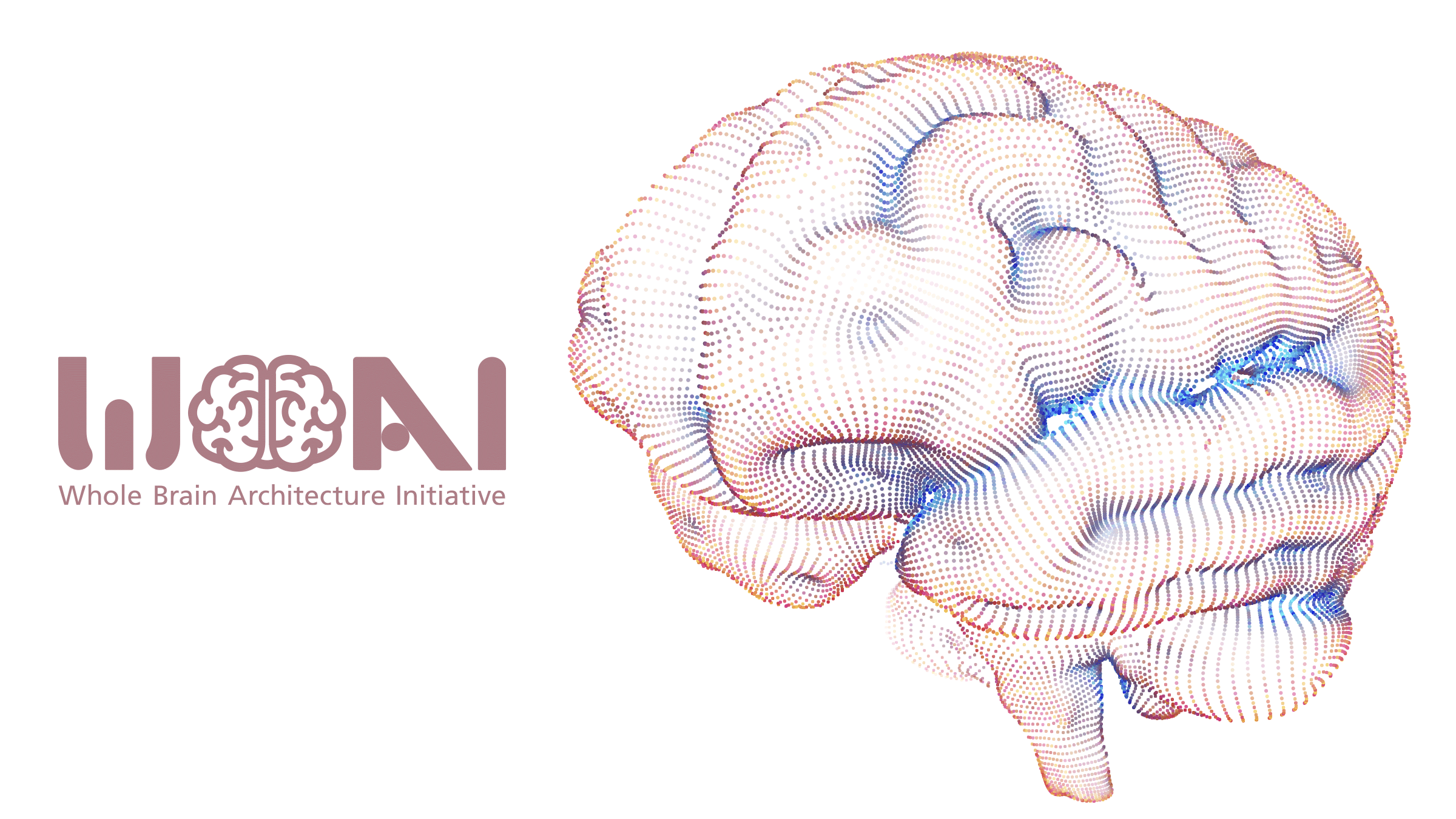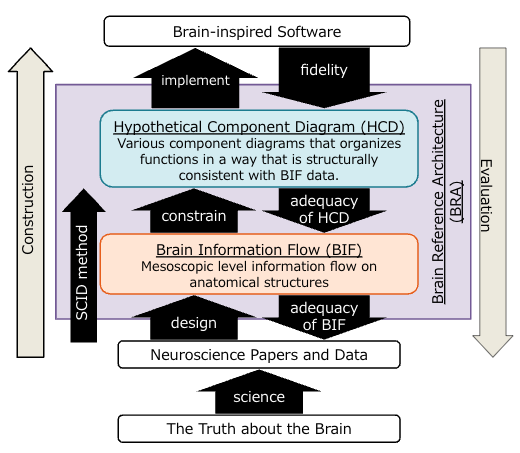Our activities in Fiscal Year 2024 (from April 2024 to March 2025 — the ninth year) include educational and R&D businesses, implemented according to our policy for FY2024.
Educational Business
The goal of our educational business is to help people who conduct research on the WBA approach on a long-term basis. In FY2024, WBAI held the ninth WBA symposium (in Japanese) and two international WBA workshops. The new workshops were aimed at fostering personnel who can create, verify, and improve BRA (brain reference architecture) data. Video recordings are available on Vimeo and YouTube.
The Ninth WBA Symposium
The symposium was held (in Japanese) online on September 18th, 2024 with the theme of “Ways to AGI from Fundamental Models and Neuroscience” with speakers Toshikazu Fukushima (JST/CRDS), and Takuya Isomura (Riken), presented by Koichi Takahashi (Riken/WBAI). There were also presentations by people at WBAI on their activities.
It was organized by WBAI, supported by the MEXT project: “Deciphering and Manipulating Brain Dynamics Underlying Emergence of Behavioral Change: a Multidisciplinary Biology Approach.”
In the symposium, David Rawlinson, who developed a system performing human-like reasoning and few-shot learning, was conferred the WBA Incentive Awards.
International WBA Workshops
IIn FY2024, WBAI held two workshops to publish, share, and integrate standardized data and data papers on the Brain Reference Architecture (BRA), for building brain-morphic artificial intelligence by understanding and mimicking the computational functions of the brain, supported by the MEXT project: “Deciphering and Manipulating Brain Dynamics Underlying Emergence of Behavioral Change: a Multidisciplinary Biology Approach.”
- The First International Whole Brain Architecture Workshop: July 16, 2024. (On-line)
- Keynote talk by Kenji Doya (OIST)
- with 114 participants
- The Second International Whole Brain Architecture Workshop: February 24, 2025 (Hybrid: On-line/Tokyo, Japan)
- with 60 participants
R&D Business
The goal of WBAI’s R&D business is to support research activities in the WBA approach. WBAI has been promoting research and development of brain-inspired AGI through Brain Reference Architecture (BRA)-driven development since FY 2018.
BRA-driven development is a methodology for developing brain-morphic software that uses the Brain Information Flow (BIF) diagrams, which represent the mesoscopic anatomical structure of the brain, and the Hypothetical Component Diagrams (HCD), which describe the computational functions consistent with the BIF. Recently, Function Realization Graphs (FRG) have been introduced to define the functions of HCD components in a hierarchical manner.
We conduct BIF creation, BRA-DB, BRA automation, HCD design, and HCD integration for BRA-driven development design. As far as implementation is concerned, we are preparing for brain-morphic implementation and validation. We are also working on establishing processes as methodologies. Below, the projects financially supported by the “Deciphering and Manipulating Brain Dynamics Underlying Emergence of Behavioral Change” are noted with (Behavioral Change), those supported by the Muhammad bin Salman Center for Future Science and Technology at the University of Tokyo with (MbSC2030), and those supported by the Matsuo-Iwasawa Laboratory of the University of Tokyo with (Matsuo-Iwasawa Lab).
Major results in FY2024 focused on detailed modeling of the hippocampal and whole-brain architecture and their application to AI systems. In particular, the development of data on the reference architecture of the brain (BRA) and the standardization of the BIF description format have strengthened the foundation for the development of brain-morphic AI systems.
Computational Models Inspired by the Hippocampus
Nakajima et al [1] developed a hippocampus-inspired global self-positioning system and proposed a way for robots to quickly recover from the kidnapping problem (in which the subject is moved to unknown positions) from an egocentric perspective. Nakajima et al [2] further presented work on the dynamics of a hippocampus-inspired spatial cognition model (Behavioral Change). As detailed support for these studies, Nakajima et al. [3] provided data on the reference architecture of the hippocampal body (TN24HippocampalFormation) to the First International Whole Brain Architecture Workshop (Behavioral Change).
Suzuki et al [4] presented data (YS24LongitudinallySegmentedDistalCA1andPeriphery) on the brain reference architecture of the longitudinally segmented distal CA1 and its surrounding areas (MbSC2030)(Behavioral Change).
Progress in Whole Brain Architecture
Yamakawa, et al. [5] presented a technology roadmap toward realizing whole-brain architecture through BRA-driven development (Behavioral Change). Maruyama, et al. conducted research on reconstructing BIF using functional motifs and explored brain-morphic software implementation methods (Behavioral Change), and registered the data (YM24Amygdala) [6] as a related reference architecture for the amygdala on BRAES, which is a portal site that supports brain-based AI development by centralizing the submission, peer review, and publication of BRA data. Ota, et al. attempted to define requirements for affective interactions in rodents as an attempt at a top-down approach to designing functional requirements and grounding them in the brain, in contrast to bottom-up functional motifs.
Creation of BRA data
Yamakawa, et al. presented a brain-consistent architecture for imagination [7] (Behavioral Change). Mizuguchi, et al. provided data (NM24VestibuloOcularReflex), reference architecture for vestibulo-ocular reflexes and presented hypotheses on functional decomposition based on network motifs of the involved neuronal nuclei [8]. Yamauchi, et al. presented a cortical microcircuit reference architecture for dynamic Bayesian inference [9][10][11] (Matsuo-Iwasawa Lab). Taniguchi, et al. investigated the neural circuitry of the amygdaloid nucleus and hippocampal interconnections and provided data (AF24Hippocampus-Amygdala) [12]. Tawatsuji investigated neural connections regarding the amygdala nucleus and higher visual cortex (inferior temporal cortex) and presented data (YT24ITcAmy) representing a hypothetical architecture for the perception of ambiguous visual stimuli [13].
Activities to make AGI Beneficial
Yamakawa presented the basic idea for the NeuroQuad framework at the First Workshop on Post-Singularity Symbiosis at AAAI-25 [14].
WBAI Activities and Volunteering
As in previous years, activities such as event organization were realized under the leadership of the WBA-Seminar Executive Committee, consisting mainly of volunteers. Other participants in the organization of the event included contracted staff at the Secretariat and regular members.
Financial Statements for FY2024
The balance sheet and cash flow for FY2024 are presented below (Table 1 and Table 2).
The revenues were 0.54 million yen and the expenditure totaled 0.72 million yen for administration and 0.80 million yen for operation (total expenditure was 1.52 million yen to yield 0.98 million yen deficit).
The businesses of WBAI have been financially supported by supporting members. (As of March 2025, there were five supporting members consisting of enterprises and individuals.).
Honoraria were paid to external speakers of the WBA Symposium. The subcontractor/outsourcing expenses for operation includes the cost of R&D, which was mostly carried out with the budget of exterior research institutions.
The expenses for secretariat personnel (shown in Subcontracting/outsourcing Expenses) were apportioned by 50% (50/50) for operating and administrative expenses. The remuneration was paid to an accountant office. The rent for the office was free of charge by courtesy of Garm, Inc.
Table 1: Balance Sheet (as of March 31, 2025)
| Items | Amount (JPY) | ||||
|---|---|---|---|---|---|
| Ⅰ
|
Assets | ||||
| 1. | Current Assets | ||||
| Cash and Saving Account | 6,396,171 | ||||
| Total Current Assets | 6,396,171 | ||||
| Total Assets | 6,396,171 | ||||
| Ⅱ
|
Liabilities | ||||
| 1. | Current Liabilities | ||||
| Withholding Taxes | 6,126 | ||||
| Total Current Liabilities | 6,126 | ||||
| Total Liabilities | 6,126 | ||||
| Ⅲ
|
Net Assets | ||||
| Retained Net Assets at the Beginning of Period | 7,370,219 | ||||
| Net assets variation | -980,174 | ||||
| Total Net Assets | 6,390,045 | ||||
| Total Liabilities and Net Assets | 6,396,171 | ||||
Table 2: Cash Flow
| Items | Amount (JPY) | ||||
| Ⅰ
|
Recurring Revenues | ||||
| 1 | Fees | ||||
| Fees from Regular Members | 140,000 | ||||
| Fees from Supporting Members | 400,000 | ||||
| Total Fees | 540,000 | ||||
| 2 | Other Revenues | ||||
| Interest Income | 730 | ||||
| Other Income | 140 | ||||
| Total Recurring Revenues | 540,870 | ||||
| Ⅱ
|
Ordinary Expenses | ||||
| 1 | Operating Expenses | ||||
| ⑴ | Total Personnel Expenses | 0 | |||
| ⑵ | Other Expenses | ||||
| Honoraria | 18,000 | ||||
| Subcontractor/outsourcing Expenses | 528,000 | ||||
| Communication | 96,614 | ||||
| Prizes/Awards | 50,000 | ||||
| Travel | 29,520 | ||||
| Total Other Expenses | 722,134 | ||||
| Total Operating Expenses | 722,134 | ||||
| 2 | Administrative Expenses | ||||
| ⑴ | Total Personnel Expenses | 0 | |||
| ⑵ | Other Expenses | ||||
| Subcontractor/Outsourcing Expenses | 528,000 | ||||
| Remuneration | 264,000 | ||||
| Other | 6,910 | ||||
| Total Other Expenses | 798,910 | ||||
| Total Administrative Expenses | 798,910 | ||||
| Total Ordinary Expenses | 1,521,044 | ||||
| Net Assets Variation of the Year | -980,174 | ||||
| Net Asset brought forward | 7,370,219 | ||||
| Net Asset carried forward | 6,390,045 | ||||
References
[1] Takeshi Nakashima, Shunsuke Otake, Akira Taniguchi, Katsuyoshi Maeyama, Lotfi El Hafi, Tadahiro Taniguchi, and Hiroshi Yamakawa: “Hippocampal Formation-Inspired Global Self-Localization: Quick Recovery from the Kidnapped Robot Problem from an Egocentric Perspective.” Frontiers in Computational Neuroscience 18, 2024. https://doi.org/10.3389/fncom.2024.1398851 .
[2] Takeshi Nakashima, Akira Taniguchi, and Hiroshi Yamakawa: “Dynamics in Spatial Cognition Model Inspired by the Hippocampal Formation.” In IJCNN 2024 Workshop WBCM-CogM, 2024. https://sites.google.com/em.ci.ritsumei.ac.jp/ijcnn2024workshop-wbcm/ .
[3] Takeshi Nakashima and Akira Taniguchi: “Data for Brain Reference Architecture of TN24HippocampalFormation.” In Proceedings of the First International Whole Brain Architecture Workshop, 2024. https://doi.org/10.51094/jxiv.802
[4] Yudai Suzuki, Yoshiko Honda, Shinya Ohara, Ayako Fukawa, and Hiroshi Yamakawa: “Data for Brain Reference Architecture of YS24LongitudinallySegmentedDistalCA1andPeriphery.” In Proceedings of the First International Whole Brain Architecture Workshop, 2024. https://doi.org/10.51094/jxiv.819 .
[5] Hiroshi Yamakawa, Yoshimasa Tawatsuji, Yuta Ashihara, Ayako Fukawa, Naoya Arakawa, Koichi Takahashi, and Yutaka Matsuo: “Technology Roadmap toward the Completion of Whole-Brain Architecture with BRA-Driven Development.” Cognitive Systems Research, no. 101300, 2024.
https://doi.org/10.1016/j.cogsys.2024.101300 .
[6] Yohei Maruyama, Tatsuya Miyamoto, Yoshimasa Tawatsuji, and Hiroshi Yamakawa: “Data for Brain Reference Architecture of YM24Amygdala.” In Proceedings of the First International Whole Brain Architecture Workshop, 2024. https://doi.org/10.51094/jxiv.775 .
[7] Hiroshi Yamakawa, Ayako Fukawa, Ikuko Eguchi Yairi, and Yutaka Matsuo: “Brain-Consistent Architecture for Imagination.” Frontiers in Systems Neuroscience 18, 2024. https://doi.org/10.3389/fnsys.2024.1302429 .
[8] Nayuta Mizuguchi, Tatsuya Miyamoto, Yoshimasa Tawatsuji, and Hiroshi Yamakawa: “Data for Brain Reference Architecture of NM24VestibuloOcularReflex.” In Proceedings of the First International Whole Brain Architecture Workshop, 2024. https://doi.org/10.51094/jxiv.775 .
[9] Yamauchi Naohiro, Tawatsuji Yoshimasa, Suzuki Yudai, and Yamakawa Hiroshi: “Cortical Micro Circuits Reference Architecture for Dynamic Bayesian Inference.” In Proceedings of 1st Digital Brain Workshop, 2024.
[10] Yamauchi Naohiro, Tawatsuji Yoshimasa, Suzuki Yudai, Doya Kenji, and Yamakawa Hiroshi: “Data for Brain Reference Architecture of NY24CanonicalCorticalMicrocircuitsInference”, In Proceedings of the Second International Whole Brain Architecture Workshop, 2025. https://doi.org/10.51094/jxiv.1047
[11] Yamauchi Naohiro, Tawatsuji Yoshimasa, Suzuki Yudai, Doya Kenji, and Yamakawa Hiroshi: “Data for Brain Reference Architecture of NY24CanonicalCorticalMicrocircuitsDecisionMaking”, In Proceedings of the Second International Whole Brain Architecture Workshop, 2025. https://doi.org/10.51094/jxiv.1048
[12] Taniguchi Akira, Fujii Atsushi, Nakashima Takeshi, Miyamoto Tatsuya, Tawatsuji Yoshimasa, and Yamakawa Hiroshi: “Data for Brain Reference Architecture of AF24Hippocampus-Amygdala”, In Proceedings of the Second International Whole Brain Architecture Workshop, 2025. https://doi.org/10.51094/jxiv.1058
[13] Tawatsuji Yoshimasa: “Data for Brain Reference Architecture of YT24ITcAmy”, In Proceedings of the Second International Whole Brain Architecture Workshop, 2025.[14] Hiroshi Yamakawa, “Ensuring the Sustainability of Digital Life Form Societies,” Proc. 1st Workshop on Post-Singularity Symbiosis, PSS-2025-010, March 3, 2025. https://openreview.net/forum?id=7ohP67l0ri




 Japanese
Japanese